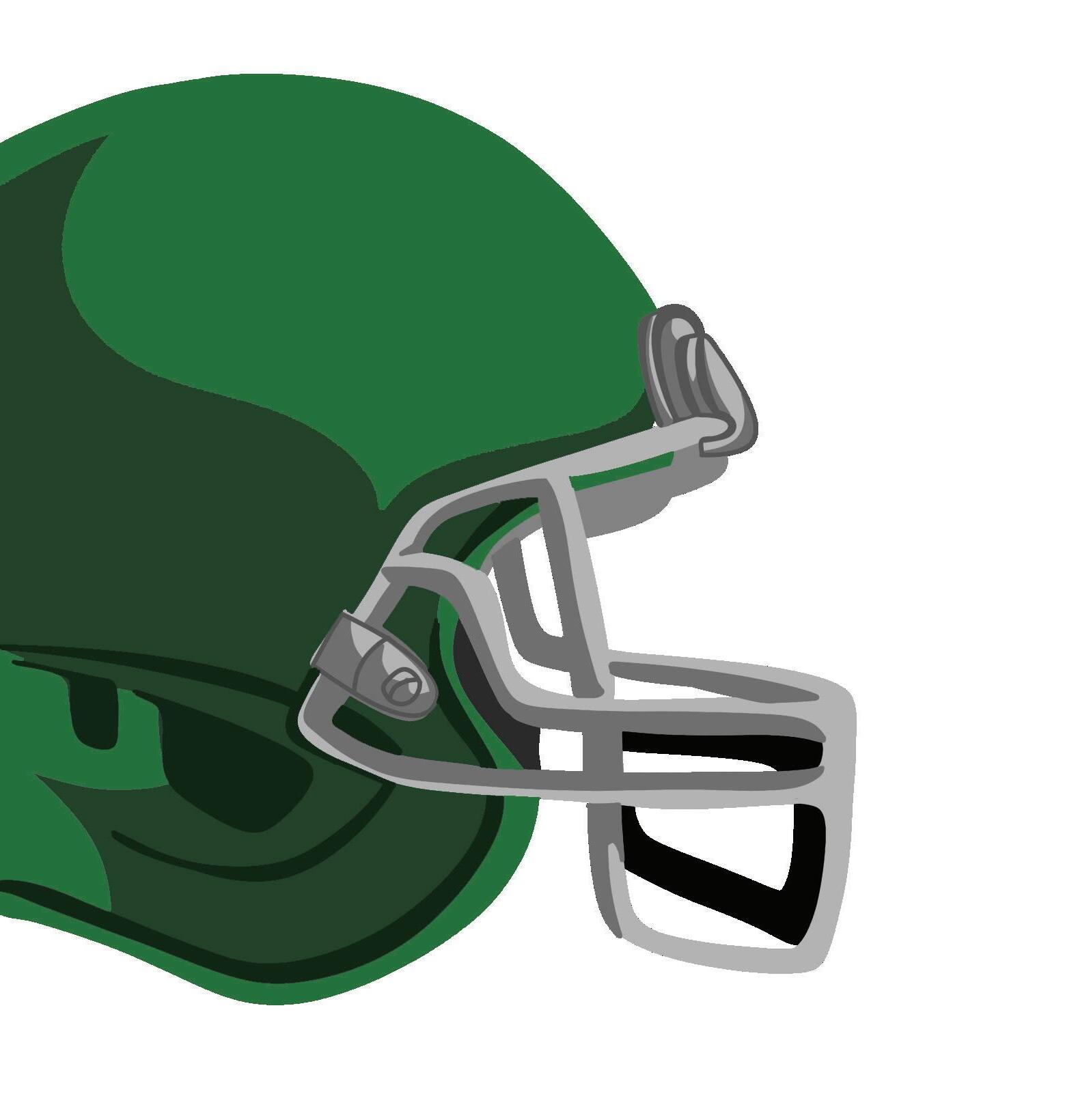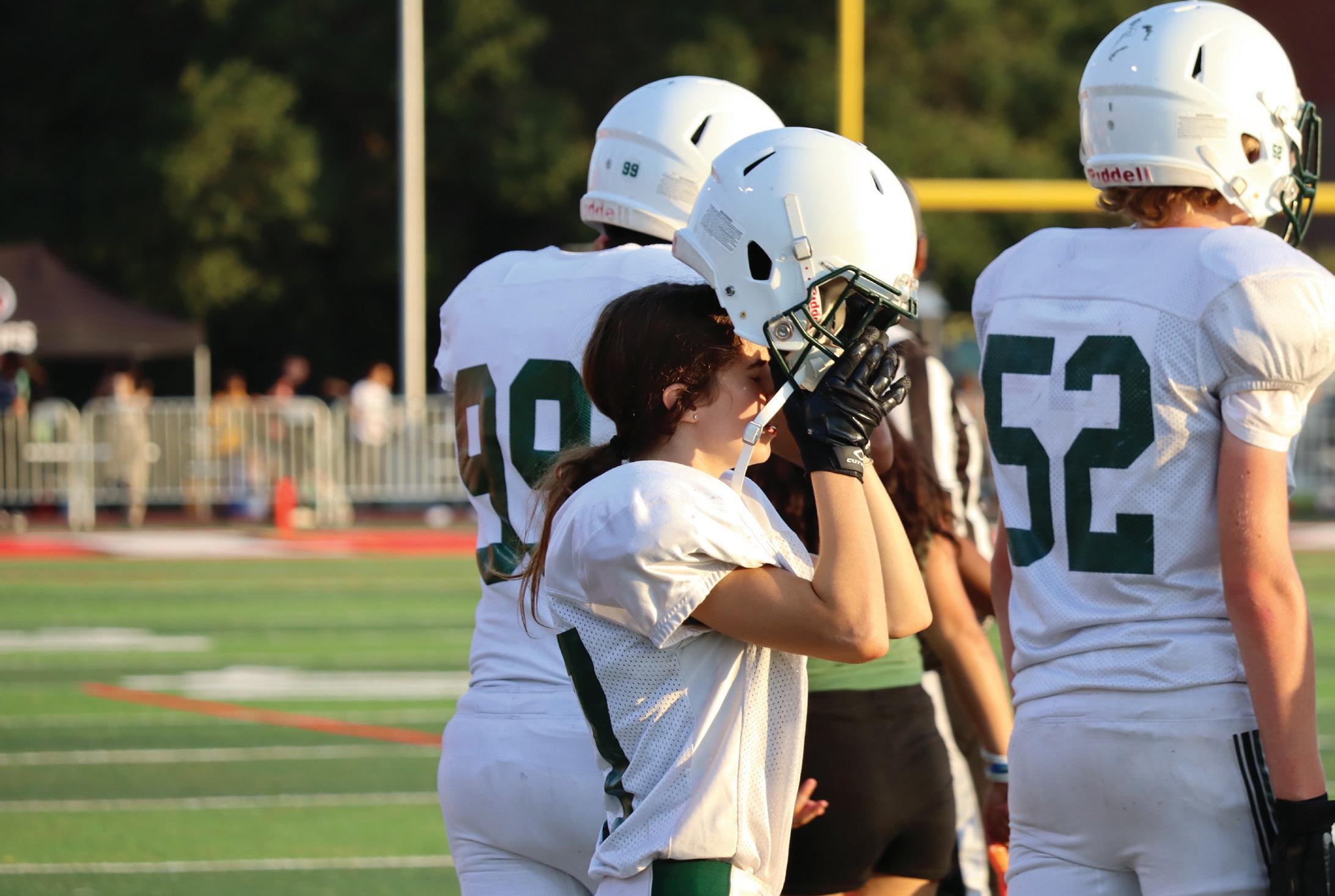
6 minute read
BYE TO BYE TO
by TYLER FRICK, LILY JEFFREY,
In a world as complicated as the one we live in today, sports may seem like a simple part of life. They reflect some deep values of society: hard work, the attempted perfection of skills, the endless repetition of small movements and working towards a larger goal. Athletics reflect the emotion and competitiveness of our society, and the physical and emotional investment in something other than our own lives.
Football
However, on a smaller scale, when breaking down individual sport to individual sport – specifically on a gender basis – athletics become more complicated, paralleling other aspects of our culture. Specifically, the different values we place on men and women. While some sports reflect strength, physicality, and aggression, others center around things like beauty, grace, and even a specific body image. Cultural precedents set hundreds of years ago between men and women are reflected in athletics and despite having progressed somewhat, reflective of our increasingly homogenized ideals between genders, the culture split in sports still reflects many discriminatory values of society. Many sports are divided by gender in terms of participation: there are female dominated sports and male dominated sports. In many cases, there are major differences in how female versus male athletes are viewed, treated, and supported when joining sports dominated by the opposite gender. For women, the ability to join “boy” sports has improved over time, especially through the introduction of Title IX in Q1972. And for men, the consistent trend of encouraging “muscle” sports has continued into our contemporary “progressive” era with little encouragement or accessibility for those who want to join “girl” sports.

A sport that exemplifies the notion of “male dominance” and other male stereotypes is football. Created in 1823, it was largely based on a mix of rugby and soccer, with an emphasis on physicality, hard hitting force, and harming or injuring others as core outcomes of each play. In fact, the game existed for about 100 years before football helmets were even invented.

In the modern age, women trying out for or joining a football team has become more common each year, mainly due to the increasingly positive attitude towards women joining these types of sports. In 2020, Vanderbilt kicker Sarah Fuller, broke boundaries and became the first woman to score in a collegiate football game. According to an article by the Business Insider, as enrollment for boys in football has declined (possibly due to rising safety concerns), more girls are playing football every year. According to NFL Operations, statistics show that 0.6% of football players in California are women, and 99.4% are men, as of the year 2018. This is an increase in female participation from 2008, where the percentage of California’s football players was 0.1% female, and 99.9% male. However, there are still currently no female tackle football teams in high schools around the U.S.
Similar positive attitudes towards this integration are seen here at Paly. While freshman Lara Saslow faced some criticism for her decision to join the JV football team as a kicker, the perspective of her peers was largely supportive and positive.
“Whenever I told one of my female friends that I was playing football they thought it was really cool,” Saslow said. “There were definitely [people] that told me that couldn’t do it because of my size, but it was mostly positive reactions.”
But this positive attitude towards women in typically male-dominated sports hasn’t always been this way. Before the establishment of Title IX in 1972, most sports were seen as a “male” activity. Before Title IX, if women played any sports, they were usually seen as ‘girly’ and only played at an amateur level. They often played tennis, bowling or croquet as hobbies with friends, but never at a competitive level. Then, when IX passed, more female dominated sports were added to school athletics, and women were given more opportunities to play more diverse sports at a competitive level.
Despite adding equal gender opportunity, the act had little control over people’s opinions of women in sports. Many women who were among those taking advantage of Title IX claimed their spot in athletics, only to be labeled “gay” or “masculine,” and discouraged from joining.
In her recent memoir Good for a Girl, Laura Freshman, California cross coun- try State Champion in 1998 and two time NCAA champion for Stanford track and field, outlines how despite the many strides this monumental act has made, sports still cater primarily to men and male bod- ies. According to the book, a 2016 study found that girls in the U.S. are “dropping out of sports at twice the rate of their male peers by age fourteen, and over half leave sports completely by age seventeen.” It also stated that the top six reasons identified for this were “differences in access, safety and transportation, social stigma as being tagged ‘gay,’ decreased quality of experience, cost, and lack of positive role models.”
Not only are many sports designed for men to play, many others are designed for men to watch. Female sports that get the most coverage are those that showcase –– and in some ways, sexualize –– female bodies through focusing largely on grace and appearance, values typically held as exemplary for women in the past. This is seen in sports like ice skating, dance, cheer, gymnastics, all typically female-dominated sports. Dance, ice skating, and cheer, for example, are even scored with appearance in mind. Although there may not be a specific section for appearance on the score sheets, it is still a huge factor in influencing – consciously or subconsciously – the judges’ decisions. Judges score depending on how coordinated the team is, how entertaining the routine is, the uniform, hair, smiles, and even actual features or bodies of the athletes. One may argue that the most graceful and impressive dancers, skaters or cheerleaders are that way because of their athleticism. This is true; the most beautiful leaps and maneuvers are often the hardest and athletes in these sports must train for strength, flexibility and endurance to be able to complete their routines. Still, many fail to appreciate the countless hours of difficult practice that these routines require, instead appreciating them for their appearance. Because of the underselling of the athlete’s talents and emphasis on entertainment and appearance in scoring, the perception of typically feminine sports is undermined. Viewers focus on what the judge sees – who has the prettiest performance – and not necessarily on the strength, power, and accomplishments of the athletes in sport. Not only does this undervalue the achievement of the female majority of the sport, but it discourages many young male athletes from joining, either implicitly or explicitly.
Saslow commented on how many people undersell the difficulty of these typically feminine sports.
“A male dancer’s friends might credit for their hard work. Gymnastics for both genders takes an extensive amount of strength and perseverance, as each event a gymnast competes in takes hours of practice and work to perfect, however, there is an exceptionally stark difference between men’s andof strength to perfect, and showcases their physicality instead of their grace. Similarly are the rings, which women also do not compete in during the Olympics. Most women perform to music, and men don’t, playing further into the idea that women perform for entertainment, and converting a sport into an art for the pleasure of the viewer, and not the athlete.
Perhaps most tellingly, both have floor routines, but women have dance requirements as well as tumbling (men only have tumbling).
This clearly shows there is a value placed on women’s athletics as entertainment instead of solely athleticism, which is typically the value placed on men’s sports. Men are placed in events that showcase their body strength, and women in events that demonstrate their agility and grace.
This may cater to the more traditional positions of men and women, but it had been a gymnast for ten years, also felt like society labeled gymnastics as feminine and weak.
“I did gymnastics for about 10 years, and throughout that time I definitely felt a kind of embarrassment for participating in a sport that was typically associated with femininity,” Chakmakchi said. “When people would ask what sport I did, I felt like I had to justify myself doing gymnastics, and would try to make clear the difference between womens and mens gymnastics so that other boys wouldn’t think less of me.”
The labeling of a sport as “girly” dis courages male participation. Because of the fear of doing an “easy” “girl” sport, many male athletes are scared to join out of a fear of judgment and prejudice from peers. Many peo ple look past the hard work put into it and mostly see the performance aspects, which can diminish the athleticism of both male and female participants.
Sophomore

Ja’Meer Cooper, a former cheerleader, experienced these discriminatory stereotypes when he performed.
“Oftentimes, people would call me “gay” or whatnot,” Cooper said. “But I didn’t really care because at the end of the day, I knew what I wanted out of cheer.”
Title IX has granted female athletes all malize both genders’ participation in any athletic activity.

“I believe that women and men can have almost if not exactly the same athletic ability as each other, it’s about the work you put in,” Cooper said. “I think it needs to be normalized that both genders can do any sport they want to, without the judgment of peers.”
These stereotypes surrounding female/ male dominated sports cause the continuance of a divide in athletics due to gender. After over fifty years since the Title IX law was passed, gender stereotypes in athletics persist, despite agreement among athletes that gender equality in sports should be normalized.



“Don’t let a stereotype stop you from what you want to do,” Cooper said. “If it’s what you want to do, put your mind to it, don’t listen to what people have to say and just go at it.”











